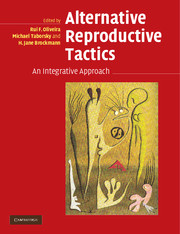Book contents
- Frontmatter
- Contents
- List of contributors
- Preface
- 1 The evolution of alternative reproductive tactics: concepts and questions
- PART I ULTIMATE CAUSES AND ORIGINS OF ALTERNATIVE REPRODUCTIVE TACTICS
- PART II PROXIMATE MECHANISMS OF ALTERNATIVE REPRODUCTIVE TACTICS
- PART III TAXONOMIC REVIEWS OF ALTERNATIVE REPRODUCTIVE TACTICS
- 8 Alternative reproductive tactics in insects
- 9 The expression of crustacean mating strategies
- 10 Alternative reproductive tactics in fish
- 11 Alternative reproductive tactics in amphibians
- 12 Alternative reproductive tactics in reptiles
- 13 Alternative reproductive tactics in birds
- 14 Alternative reproductive tactics in nonprimate male mammals
- 15 Alternative reproductive tactics in primates
- PART IV EMERGING PERSPECTIVES ON ALTERNATIVE REPRODUCTIVE TACTICS
- Index of species
- Subject index
- References
10 - Alternative reproductive tactics in fish
Published online by Cambridge University Press: 10 August 2009
- Frontmatter
- Contents
- List of contributors
- Preface
- 1 The evolution of alternative reproductive tactics: concepts and questions
- PART I ULTIMATE CAUSES AND ORIGINS OF ALTERNATIVE REPRODUCTIVE TACTICS
- PART II PROXIMATE MECHANISMS OF ALTERNATIVE REPRODUCTIVE TACTICS
- PART III TAXONOMIC REVIEWS OF ALTERNATIVE REPRODUCTIVE TACTICS
- 8 Alternative reproductive tactics in insects
- 9 The expression of crustacean mating strategies
- 10 Alternative reproductive tactics in fish
- 11 Alternative reproductive tactics in amphibians
- 12 Alternative reproductive tactics in reptiles
- 13 Alternative reproductive tactics in birds
- 14 Alternative reproductive tactics in nonprimate male mammals
- 15 Alternative reproductive tactics in primates
- PART IV EMERGING PERSPECTIVES ON ALTERNATIVE REPRODUCTIVE TACTICS
- Index of species
- Subject index
- References
Summary
CHAPTER SUMMARY
Among vertebrates, fish show by far the greatest variability of alternative reproductive tactics (ARTs). Usually, males attempting to monopolize access to females or fertilizations are parasitized by conspecific male competitors (Taborsky 1997). This is so common in fish (Mank and Avise 2006) that it appears to be the rule rather than the exception: in fish with external fertilization, 170 species belonging to 32 families have been described to show ARTs (Table 10.1). Apart from being common, ARTs in fish are also exceptionally variable. Parasitic males exploiting the effort of conspecific competitors may do so by surreptitious participation in spawning; they may mimic females in appearance and behavior to reach their goal; intercept approaching mates or steal eggs from neighbors to attract mates to their nest; force copulations in viviparous species; gain access to mates by cooperating with their competitors; or oust a territory owner aggressively to spawn in his nest before letting him care for their brood. Sometimes, three or more alternative tactics may exist within a species (Taborsky 1994, 2001, Avise et al. 2002). Our understanding of sexual selection mechanisms and the concepts underlying conventional classifications of mating patterns largely ignore the existence and importance of ARTs (Emlen and Oring 1977, Wittenberger 1979, Davies 1991, Andersson 1994, 2005). One could argue that the way reproductive behaviour in animals is viewed and categorized today would be different if it had been developed on the basis of fish reproduction instead of bird mating systems.
Information
- Type
- Chapter
- Information
- Alternative Reproductive TacticsAn Integrative Approach, pp. 251 - 299Publisher: Cambridge University PressPrint publication year: 2008
References
Accessibility standard: Unknown
Why this information is here
This section outlines the accessibility features of this content - including support for screen readers, full keyboard navigation and high-contrast display options. This may not be relevant for you.Accessibility Information
- 105
- Cited by
